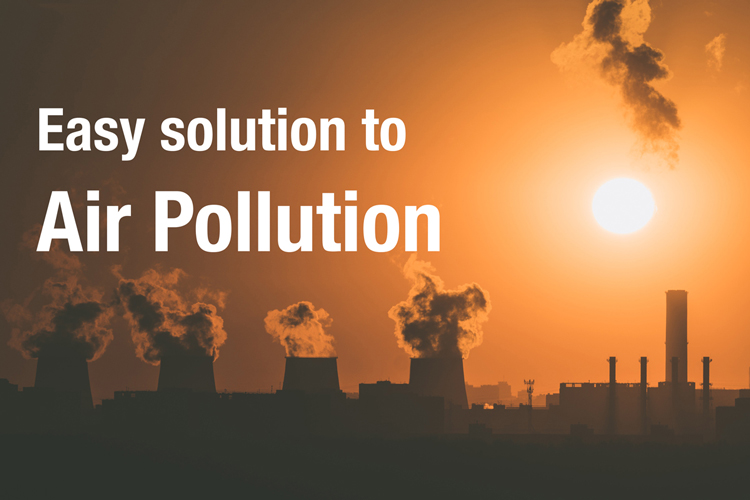As we see, the environment around us is detrimentally deteriorating at an ever-faster rate. It is high time now to seriously take into consideration all solutions to air pollution. If not perhaps the consequences of our actions are soon awaiting us. In fact, India is present among the top few countries with hazardous AQI. Also, India accounts for having the most polluted cities in the global scenario.
While many countries are gearing up to find innovative solutions to combat air pollution, China has already developed an air purifier in the form of a giant 100-meter tower. The Netherlands came forward with a plan to ban the sale of petrol and diesel cars by 2025.
What is air pollution?
Air pollution is the presence of harmful air pollutants in the air beyond the safety limits. The major air pollutants include particulate matter (PM 2.5 and PM 10) and poisonous gases (ozone, oxides of nitrogen, carbon monoxide, sulphur dioxide), these pollutants pose deleterious effects on the surroundings.
What are the causes of air pollution?
In India, dust from construction causes a whopping 43% of air pollution followed by waste burning (17%), transport (14%), diesel generators (9%), industries (8%), and domestic cooking (7%). Dust from construction activities is a major cause of air pollution in urban areas, while waste burning is in rural areas.
How can we prevent air pollution?
- Use of advanced techniques in construction and agricultural waste burning.
- Promoting electric motor vehicles and taking public transport as much as possible.
- Planting more trees to naturally lower CO2 levels.
- Practicing industrial activities away from residential areas.
What are the innovative solutions to fight air pollution?
Nanotechnology for air pollution
Nanotechnology may provide a potent remediation technique to reduce air pollution. Nanoparticles can act as a catalyst to adsorb pollutants. Since the surface area of the nanoparticles is high, it is an excellent choice as a catalyst. Further, nanostructured membranes or carbon nanotubes (CNT) based membranes are also efficient tools to reduce air pollution. Nanostructured filters or membranes serve to trap or adsorb pollutants emitted from industries, vehicles, or ambient air.
Nanoparticles used to reduce air pollution
An effective method to remove NO from smokestacks is by using CNT in the form of nanocatalysts containing cobalt & platinum. Carbon nanotube membranes are efficient enough to adsorb stable and harmful pollutants like dioxins, NO2, and CO2. Nanoparticles are also being employed to harvest CO2 from the atmosphere and convert it to useful products that can serve industrial purposes.
Harvesting CO2 through nanoparticles offers a promising approach to mitigating problems pertaining to climate change and global warming. So far, the challenge is to make this project economically viable, however, researchers are trying to make this process efficient enough for industrial-scale applications.
Bioremediation as a solution to air pollution
The technique of employing living microorganisms to degrade or reduce toxic pollutants to their lesser toxic or non-toxic forms is Bioremediation.
Bioremediation comes to the rescue in the form of bio-filtration which helps to clean industrial gases. This method involves passing polluted air over a replaceable culture medium. This medium contains microbes that degrade contaminants to carbon dioxide, water, or salts.
Implications of Bioremediation
Bio-filtration is the most commonly practiced technique currently available to remediate pollutants. The substances filtered out still pose a threat to the environment, as removing waste only to return it to the ground leaves no net benefit.
Therefore, a Japanese researcher, in 2006 found a novel way to collect the soot filtered out of diesel fuel emissions and recycle it into manufacturing material for Carbon Nanotubes (CNT). The diesel soot is used to synthesize the single-walled CNT filter through laser vaporization so that essentially, the filtered waste becomes the filter.
Concerns pertaining to new technologies
Bioremediation and Nanotechnology provide promising solutions to mitigate pollution, however adequate guidelines and safety measures should be prioritized. The best way to stop pollution from reaching harmful levels is to use cleaner alternatives. Innovatively utilizing renewable energy sources and implementing sophisticated methods of construction will reduce the toxicity level in the air to a considerably lesser level.
Here is a list of a few more interesting topics like ‘sustainability in healthcare industries‘ and ‘nano-medicine‘.

[…] Air pollution is one of the biggest environmental challenges facing the world today. The transportation sector is a major contributor to air pollution, with vehicles powered by fossil fuels emitting harmful pollutants into the air. Electric vehicles (EVs) offer a promising solution to this problem, as they produce no exhaust emissions and can significantly reduce air pollution. In this blog post, we will explore the solutions to air pollution with EVs. […]
Hi there this is kind of of off topic but I was wanting to know if blogs
use WYSIWYG editors or if you have to manually code with HTML.
I’m starting a blog soon but have no coding knowledge so I wanted to get guidance from someone with
experience. Any help would be enormously appreciated!
[…] its ability to reduce greenhouse gas emissions. Carbon capture technology can capture up to 90% of CO2 emissions from power plants and other industrial sources. By capturing these emissions, we can prevent them […]